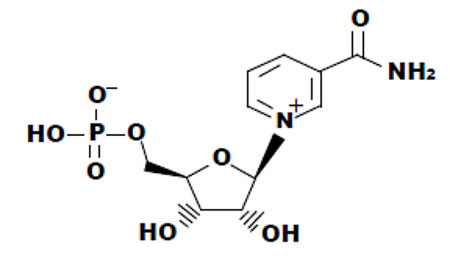- Home
- Bioindustry Business
- β−Nicotinamide mononucleotide / β-NMN
β−Nicotinamide mononucleotide / β-NMN
We can provide NMN as raw material only for research use.
Our NMN is NOT for pharmaceuticals, supplements or personal consumption.
Product features in specifications:
Molecular Formula: C11H15N2O8P
Molecular Weight: 334.22
Appearance: Lyophilized white powder
Purity: ≧95% (HPLC)
Water contents: < 8 %
Molecular extinction coefficient at 260 nm: 4200±200 L・mole-1・cm-1
Recommended storage conditions: below -20℃ in dry for long-term
Chemical Structure

Beta-Nicotinamide mononucleotide (NMN) is an intermediate of NAD+ biosynthesis produced from nicotinamide through nicotinamide phosphoribosyltransferase (NAMPT) and also referred to as NMN or nicotinamide ribotide. In recent studies of NMN applications to prevention and diagnosis of age-dependent diseases such as diabetes, neurodegenerative disorder, cardiac disease etc., it has become one of hottest biomarkers on discussion for anti-aging, lately. As one of worldwide leading manufacturers, we are now providing highly qualified fully physiologically active, beta-Nicotinamide mononucleotide (NMN) as to support basic research in not only Academia but also Pharmaceuticals.
Brief summary about β-NMN
NAD+ exists in all living organisms and is well known as a coenzyme in oxidation−reduction reaction. Recent research has drawn attention to its relation to “sirtuin” represented by NAD+−dependent protein deacetylases such as Sirt1 and Sirt3. Because Sirt1 is reported to regulate various life phenomena as aging, people is especially paying high attention to “Anti-aging effect” associated with the activated sirtuin through Sirtuin/SIRT1−activating components (STACs) as represented by resveratrol. Meanwhile, sirtuin is NAD+−dependent and increase of cellular NAD+ level is expected to have similar effects to the STACs, thus nicotinamide mononucleotide, an intermediate of NAD+ biosynthesis, is also in the spotlight.
While absorption of nicotinamide mononucleotide into body and its functional mechanism remain unclear in many respects and are being studied, it is reported that administration tests of nicotinamide mononucleotide into mice show improvement of high fat diet-induced glucose intolerance1), restoration of mitochondrial dysfunction with age2) and reduction of infarct area in response to ischemia/reperfusion3), and that the other chronic administration study in mice indicates rescue effect of age-associated decline in neural stem cells4). Application of nicotinamide mononucleotide for prevention and diagnosis of age-dependent diseases such as diabetes, neurodegenerative disorder, cardiac disease etc. raises high expectation for anti-aging.
Packing size
NMN
| Catalog No. | Packing size |
|---|---|
| 44501000 | 1 g |
| 44501900 | bulk inquired |
References
1) Yoshino J, Mills KF, Yoon MJ, Imai S (2011) Nicotinamide mononucleotide, a key NAD+ intermediate, treats the pathophysiology of diet- and age-induced diabetes in mice. Cell Metab. 14 : 528-536
2) Gomes AP, Price NL, Ling AJ, Moslehi JJ, Montgomery MK, Rajman L, White JP, Teodoro JS, Wrann CD, Hubbard BP, Mercken EM, Palmeira CM, de Cabo R, Rolo AP, Turner N, Bell EL, Sinclair DA.(2013) Declining NAD+ induces a pseudohypoxic state disrupting nuclear-mitochondrial communication during aging. Cell 155 : 1624-1638
3) Yamamoto T, Byun J, Zhai P, Ikeda Y, Oka S, Sadoshima J. (2014) Nicotinamide mononucleotide, an intermediate of NAD+ synthesis, Protects the heart from ischemia and reperfusion. PLoS One. 9 : e98972}
4) Stein LR, Imai S (2014) Specific ablation of Nampt in adult neural stem cells recapitulates their functional defects during aging. EMBO J. 33: 1321-1340
